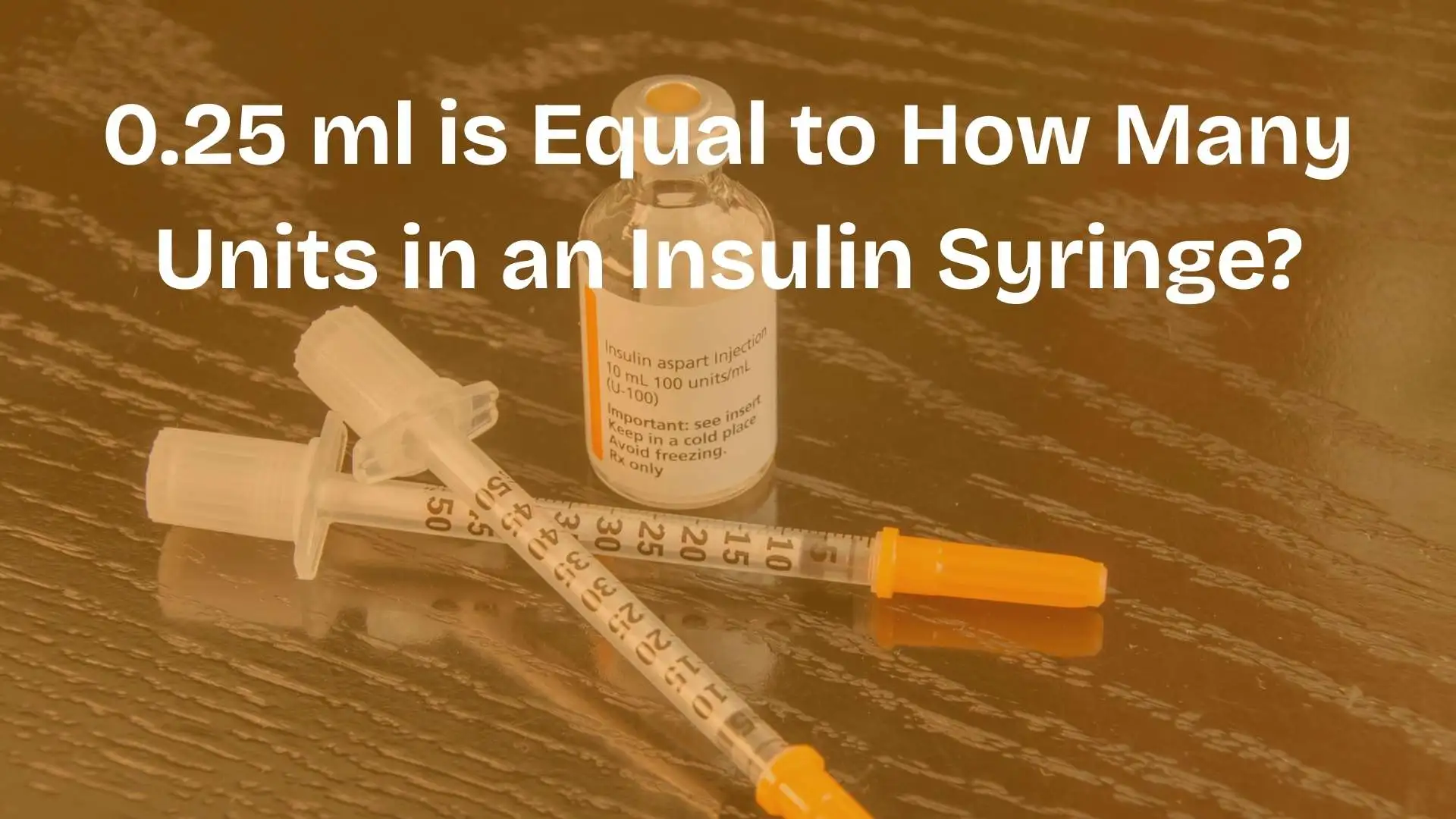If you’re new to insulin syringes or just trying to figure out medical measurements, you might wonder: “How many units is 0.25 ml?”
The answer is important for accurate dosing, whether for insulin, certain medications, or even pet care.
In this guide, we’ll break it down in simple terms so anyone can understand.
Understanding the Two Units | Milliliters (ml) and Insulin Units
Before converting, let’s understand the two measurements involved:
- Milliliter (ml)
- A standard metric unit for measuring liquid volume.
- Common in medicine, cooking, and science.
- 1 ml = 1/1000 of a liter.
- A standard metric unit for measuring liquid volume.
- Insulin Units (U)
- Specific to insulin concentration.
- In the U-100 standard (most common), 1 ml = 100 insulin units.
- The “U” stands for “units of insulin.”
- Specific to insulin concentration.
💡 Important: The conversion depends on the insulin concentration. Here, we are using U-100 insulin, which is the standard in the US and many countries.
The Direct Conversion Answer
In U-100 insulin:
1 ml = 100 units
So,
0.25 ml × 100 = 25 units
✅ Answer: 0.25 ml = 25 units in a U-100 insulin syringe.
Conversion Chart | ml to Units (U-100 Insulin)
| Milliliters (ml) | Units (U) |
| 0.1 ml | 10 units |
| 0.15 ml | 15 units |
| 0.2 ml | 20 units |
| 0.25 ml | 25 units |
| 0.3 ml | 30 units |
| 0.5 ml | 50 units |
| 1.0 ml | 100 units |
Why This Conversion Matters in Real Life
Knowing that 0.25 ml equals 25 units is critical for:
- Diabetes management – Ensuring correct insulin dosage for blood sugar control.
- Pet care – Many cats and dogs require insulin injections.
- Medical dosing – Certain liquid medicines also use “units” for accuracy.
Even a small error in dosage can have serious health effects — that’s why precision matters.
How to Easily Remember the Conversion
Here’s a simple trick:
- Think “U-100 means 100 units per ml.”
- For 0.25 ml, just take a quarter of 100 = 25 units.
Memory hack: Quarter ml = Quarter of 100 = 25.
Common Mistakes and Tips for Accurate Measuring
Mistakes to Avoid:
- Confusing U-40 and U-100 syringes.
- Mixing up ml with units without checking concentration.
- Rounding incorrectly when converting.
Tips:
- Always double-check insulin concentration.
- Use the correct syringe for your insulin type.
- Mark your dosage on the syringe barrel to avoid mistakes.
Measurement Difference
In U-40 insulin (less common, used in some countries and for pets):
- 1 ml = 40 units
- 0.25 ml = 10 units
This is a huge difference — so always confirm the type before calculating.
Real Life Examples of When You Need This Conversion
- A doctor prescribes 0.25 ml of U-100 insulin — you know that’s 25 units.
- Your diabetic cat needs 25 units — you draw 0.25 ml in a U-100 syringe.
- Traveling abroad — you can convert ml to units to match local syringes.
FAQ | 0.25 ml to Units in an Insulin Syringe
1. How many units is 0.25 ml in a U-100 syringe?
→ 25 units.
2. How do I convert ml to units?
→ Multiply ml by 100 for U-100 insulin.
3. What if I have U-40 insulin?
→ Multiply ml by 40 instead.
4. Can I use a U-40 syringe for U-100 insulin?
→ No, it will give incorrect dosing.
5. Is 0.25 ml the same as 25 units for all medicines?
→ No, only if the medicine’s concentration is 100 units/ml.
6. Why do some syringes measure in units instead of ml?
→ It makes dosing easier for insulin users, as units are more intuitive.
Conclusion
0.25 ml in a U-100 insulin syringe equals 25 units — but always double-check the insulin type and syringe markings for safety. Accurate dosing is essential for health, whether for you or your pets.

Thomas Gray is a seasoned writer and researcher with a passion for uncovering the layers of language, culture, and human expression. With years of experience in content creation and linguistic exploration, he brings clarity and depth to complex subjects, making them accessible and engaging for readers worldwide. His work often blends academic rigor with a storyteller’s voice, earning him recognition in both digital and print publishing circles.
Thomas has contributed extensively to educational platforms, language-focused blogs, and international publications. His keen eye for detail and commitment to accuracy make him a trusted voice in the fields of linguistics, history, and cultural studies.
He is the author of several professional works, including “The Language Atlas“, “Global Words: A Linguistic Journey Across Cultures“, and “Meaning in Translation: Bridging Words and Worlds.”




